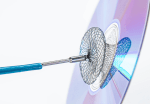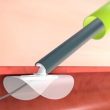Cryptogenic stroke patients with migraine have high prevalence (79%) of patent foramen ovale (PFO) with right to left shunt. However, the timing of stroke in migraineurs is not usually associated to a migraine attack. These observations are consistent with the hypothesis that the most likely mechanism of stroke in these patients with migraine is a...
Closure of Patent Foramen Ovale for the Treatment of Migraine
Migraine is one of the more frequent disabling disorders worldwide, but its physiopathology remains unclear. Since migraine is quite heterogeneous, individual therapies may not be effective for all patients. We still lack strategies to help us predict which patient subset might respond best to certain therapies. Read also: “Amplatzer and Figulla Devices Prove to Be...
PRIMA: Closure of patent foramen ovale in patients with migraine with aura refractory
It is hypothesized that the presence of a right-left shunt can trigger migraine attacks. The aim of this study was to evaluate whether the closure of a patent foramen ovale may help treat patients with migraine with aura refractory to treatment. A total of 107 patients were included; 53 in the group of foramen ovale...
What do adults have in common with unexplained stroke, patients with migraine with aura and divers with decompression mishaps?
A small hole in the atrial septum can cause any severe neurological disorders, patent foramen ovale (PFO) – a cause or trigger that today can be given safe treatment without drug therapy for a long duration. Before birth there is a connection between the two atria, which closes immediately after birth, but for approximately 20%...
Transcatheter Closure of Patent Foramen Ovale in Thrombophilia Patients
The transcatheter treatment of patent foramen ovale (PFO) has been shown to reduce thromboembolic events in patients with cryptogenic stroke. However, most of large randomized studies have failed to include patients with thrombophilia, either inherited or acquired. For instance, the RESPECT study excluded patients with antiphospholipid antibodies (AFA) or hyperhomocysteinemia, while the REDUCE screened for...
Spontaneous Coronary Artery Dissection: Are There Differences Between Men and Women?
Spontaneous coronary artery dissection is one of the causes of acute coronary syndrome, with a prevalence between 1 and 4%, that might reach up to 35% in women <50 years old, according to recent studies. As dissections are more frequent in women, research focuses on this population. Small retrospective studies have shown different triggers and predisposing...
Spontaneous Coronary Artery Dissection: Treatment and Prognosis
Spontaneous coronary artery dissection (SCAD) is a non-traumatic nor iatrogenic event that causes a separation of the coronary artery tissue due to an intimal tear or a mural spontaneous hemorrhage. This event is most frequent in young females and usually causes an acute myocardial infarction that could be major. It accounts for 1% to 4%...
DEFENSE-PFO: High Risk PFO Closure Reduces Combined Events and Stroke Risk
High risk patent foramen ovale closure PFO resulted in reduced stroke, vascular death and bleeding risk. Recent reports have shown a favorable role of PFO in patients with cryptogenic stroke, though with some unclear results, which immediately raised the questions: Who are the optimal candidates for this procedure, and who will see no benefit? ...
Significant Association Between Suprarenal Fixation of Endoprostheses and Renal Dysfunction
According to this meta-analysis, soon to be published in Eur. J. Vasc. Endovasc. Surg., endovascular abdominal aortic aneurysm repair prostheses with suprarenal fixation do not alter significantly the glomerular filtration rate at one year from device implantation. However, we should acknowledge that long-term outcomes are still unknown. The literature is inconsistent as regards the definition...
Constrictive Pericarditis After Pericardiocentesis
All interventional cardiologists must be able to perform a pericardiocentesis. Whether we deal with a chronic total occlusion, a supposedly simple coronary angioplasty (we all have witnessed the perforation of a supposedly risk-free coronary artery), or a transcatheter aortic valve replacement (whose rise gave us another significant source of tamponades), we must all be ready...
- 1
- 2









